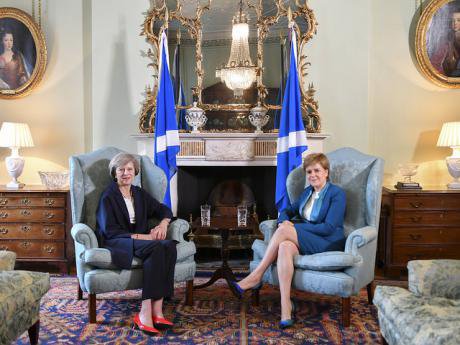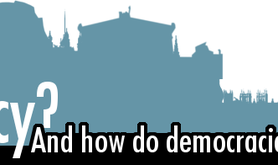

Prime Minister Theresa May meets Scotland's First Minister Nicola Sturgeon at Bute House, Edinburgh, July 2016. Credit: Flickr/Number 10. Some rights reserved.At the Fawcett Society we argue repeatedly for women to be at the decision-making table.
To be honest, I take it for granted that it’s generally accepted as morally right for 52% of the population to be represented, that the evidence on better decision-making in a gender-balanced boardroom is pretty compelling, and that we get better, more relevant, more representative politics with women involved. Few people argue against the ‘why’ any more, although they often struggle with the ‘how’ (which is why, incidentally, we argue for quotas. It gets over the ‘how’ problem).
In my usual way, I argued for women to be better represented in a meeting recently — and then someone piped up to say, “But why does it matter?” She (for it was a she) seemed genuinely puzzled as to why we should be trying to get more women into positions of political or decision-making power. In return I was given pause for thought and reminded that even now, in 2016, we mustn’t be complacent or naïve in thinking that the argument is won.
READ MORE: The ‘problem’ of women and politics has not gone awaySo what do women bring to the party? Let’s start at the top.
There have been a few column inches written already about the significance of Theresa May, Angela Merkel and — hopefully — Hilary Clinton leading the world. Commentators seem to think that between them they will transform the way that we do politics. What is telling about this is the expectation loaded onto women’s shoulders that never seems to apply to men. I think it is a little more modest, but not less significant.
There is still a novelty value in seeing women leading our politics
Women leaders (like men) make mistakes, are unpopular and encounter all the political difficulties and challenges that men do. But they will also have a few more challenges than their male counterparts to contend with, largely driven by the fact that they are still operating very much in a man-made world. And they will do it differently and make a difference too.
The fact is that there is still a novelty value in seeing women leading our politics. We aren’t used to it. So it does look and sound refreshing and it sends a positive message to young women out there. Remember the sight of First Minister of Scotland Nicola Sturgeon and Theresa May together soon after May took over at Number 10? The business-like, practical way they presented their discussion afterwards suggested that it had been an ego-free zone. We don’t tend to get that with men.
Women also tend to prioritise different issues than men. For example, we saw 50:50 representation in the Welsh Assembly in 2003. Within the first two terms, women Assembly Members were responsible for raising childcare 62% of the times it was debated, for raising domestic violence 74% of the time and equal pay 65% of the time. This resulted in tangible changes in policy: from longer maternity leave for teachers to housing priority for women fleeing domestic violence.
'More male than the men' or 'weak'
Thinking about women in other leadership roles — for instance in the boardroom — what can we expect of them there? Generalising about why and how women are different leads to the accusation of stereotyping, so I heavily caveat all of this with a ‘women tend to’ preface.
What we expect of women and how they are judged as leaders is heavily driven by the cultural norms and gender stereotypes that we are all subject to throughout our lives. So women are accused of being ‘more male than the men’ or ‘ball breakers’ if they are ‘too’ strong, but if they were men their leadership style would be acceptable. If they are good listeners, warm, open, engaging, then somehow that makes them ‘weak’ leaders according to the man-made textbook. Yet increasingly those ‘female’ qualities are being sought after by boards who realise that if they want to avoid group-think, improve board performance and make better decisions they had better get women around their board table.
READ MORE: Is it enough to give women political power?
So, what do women in leadership roles need in order to get there and stay there? If you talk to the experts on this they will tell you that it comes down to three things: networks, confidence and opportunity. Women often don’t have the networks around them to help them get to the top. That presents a problem with the club-like nature of leadership. A recent Equality and Human Rights Commission report found that one third of FTSE 350 companies rely on personal networks of current or recent board members. They are fishing in a pretty small pool in that case.
That lifetime of conditioning to put ourselves second takes a bit of coached self-belief to shake off
Next, we have confidence. I always baulk at this one because the women I see at the top seem pretty confident to me — but it is true to say that women need to be asked and prompted to put themselves forward. They don’t have that inner voice saying "Of course it should be me". The evidence on job applications is very compelling where women won’t apply unless they can do almost all of the tasks on the job description whereas men will go for it even if they can only point to experience of a few. That lifetime of conditioning to put ourselves second, to believe that men are ‘naturally’ the leaders takes a bit of coached self-belief to shake off. So sending the message that, of course, women can and should put themselves forward is important.
Which leads us to opportunity. An open, seemingly fair and transparent process may be enough. Or it may not. If we take the world of politics again we find that the single most effective way to overcome the conscious and unconscious bias in the system is to create all-women shortlists. If you look around the world, 80% of the countries with more than a third of women MPs have used some form of quota.
Similarly, quotas to get women on boards are used elsewhere to overcome what is in effect a closed system. We’d rather not need them, but in the absence of a meritocracy it is what works. Similarly, we need targets to get more women into executive positions. Making room for women is a minimum requirement. But if we do we’ll find that miraculously women leaders appear.
This article is published in association with the Westminster Foundation for Democracy, which is seeking to contribute to public knowledge about effective democracy-strengthening by leading a discussion on openDemocracy about what approaches work best. Views expressed herein do not necessarily reflect those of WFD. WFD’s programmes bring together parliamentary and political party expertise to help developing countries and countries transitioning to democracy.
Read more
Get our weekly email


Comments
We encourage anyone to comment, please consult the oD commenting guidelines if you have any questions.